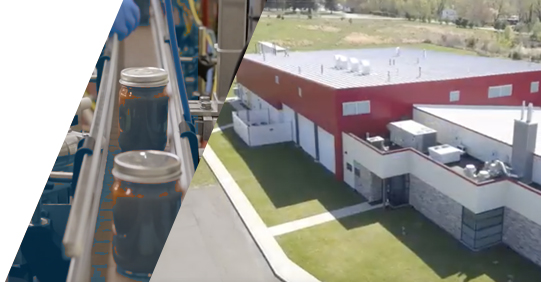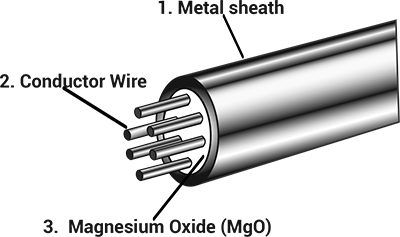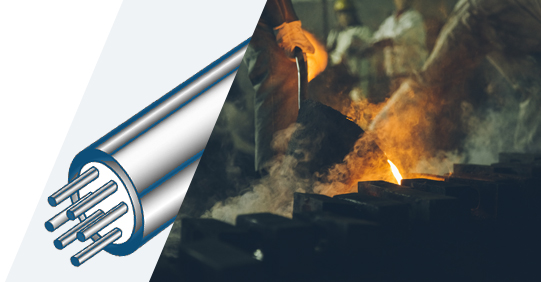3 Considerations to Take Before Installing Immersion Sensors in Process Piping Systems
When it comes to process piping systems, temperature of in-pipe media is often a necessary measurement – and one that needs to be monitored accurately. Traditionally, in-pipe immersion sensors are used. While immersion sensors are highly accurate and responsive to temperature change, they are also highly invasive, coming in direct contact with the process media in the pipe; not to mention the added maintenance cost and downtime associated with lengthy installation if a sensing location needs to be added or moved. As a result, invasive in-pipe immersion sensors are often not ideal for use within process piping systems.
Here are 3 considerations to take before installing invasive in-pipe immersion sensors in a process piping system:
Piping System Layout, Size, and Composition
The first consideration to account for prior to installation is the actual size, composition, and layout of the piping system itself. While immersion sensors are relatively compact and have been engineered for use in process piping systems, there are, ultimately, limitations to where and how they can be installed within a given system.
Because the installation process of immersion sensors is so invasive, the physical layout of the system must be taken into consideration. The mounting and installation of immersion sensors can be hindered by such variables as bulky connections, elbows, inlet/outlet runs, skid size, and the distance to other equipment and/or walls. To put it bluntly, the smaller and tighter the space, and the more “things” in the way, the harder it is to install an immersion sensor.
In-pipe immersion sensors require, as their name suggests, the installation of a probe within the pipe – be it the sensor itself or a protective thermowell. Because sensor accuracy will be compromised by an immersion depth that is less than ideal, it is best practice to have an immersion probe depth of at least 15 times the diameter of the probe. So, a ¼” probe needs at least 3.75” of immersion depth. If the pipe diameter is less than 3.75”, then either the sensor fitting must be welded at an odd angle, which is not ideal, or a sensor T is needed. A system that features high-pressure pipes may also pose a unique challenge, as these types of pipes are more difficult to penetrate and modify.
Media Composition
Since in-pipe immersion temperature sensors require direct contact with the process media they are measuring, media composition and its subsequent effect on the immersion sensor or the thermowell is another consideration to account for before installation.
When an immersion sensor or a thermowell is used, it is placed in the path of the process media flow. This exposure can lead to media build up on or around the sensor or thermowell, causing ‘sensor drift’ and jeopardizing the accuracy of the measurement.
Piping process systems that require high pressure, systems that process media with harsh chemicals or toxic properties, and systems that process solids or heavy liquid media can damage or break an immersion sensor or a thermowell. Ultimately, the replacement of the sensor or thermowell is necessary – which means shutting down the system and unavoidable maintenance downtime.
Conversely, the immersion sensor or thermowell’s effect on the media must also be taken into consideration. If the process media contains dissolved oxygen or other gasses, the contact from an invasive sensor may create fluid turbulence within the system. This may, in turn, create unwanted decarbonation (i.e. foam) – an important consideration for both the alcohol and non-alcohol beverage industries. If the process media requires specific sanitation levels, the immersion sensor or thermowell could present a contamination risk to the process media itself.
Process System Cleaning
A third consideration to account for when installing in-pipe immersion sensors in a process piping system is the frequency and method in which the system is cleaned.
Because an immersion sensor and/or thermowell must be installed physically within the pipe, obstruction of the pipe is unavoidable. For cleaning processes like pigging or COP (Clean Out of Place), the process piping system must be cleared of all obstructions – which means removing the in-pipe sensor and/or thermowell and then reinstalling once cleaning is completed. This leads to the extended shutdown of media flow and unavoidable downtime.
Since immersion sensors make direct physical contact with the process media within the pipe, they also add a potential for bacteria buildup. This not only creates a risk of contamination of the process media, but it also makes cleaning the system more difficult - no matter what cleaning process is being used.
Solution
Omega’s HANI High Accuracy, Non-Invasive Clamp Temperature Sensor addresses these challenges and delivers highly accurate, non-invasive, in-pipe temperature readings with the quickest and easiest installation process of any sensor on the market today.
Small piping skid with a small diameter pipe? No problem! Omega’s innovative, compact clamp-on design makes the HANI Clamp sensor ideal for small or hard to reach places. And, since the sensor is attached directly to the outside of a pipe, there is no need for pipe cutting, welding, in-pipe sensors and/or thermowells, or modifications of any kind. The HANI Clamp Sensor can be attached to most metal pipes used in process piping systems, both Sanitary and Industrial, and can be calibrated for variations in grade or polish, coatings, and corrosion.
Successful early customer adoption, feedback, and unique requirements have driven rapid design improvements that will introduce additional diameters/sizes as well as application for other pipe materials – including plastic pipes for application in the Semiconductor industry and glass pipes for the Chemicals and Life Sciences industries.
Also, because the Omega HANI Clamp Sensor is non-invasive and never comes in contact with the process media flowing through the pipe, media composition has no effect on the sensor and the risk of contamination is eliminated.
Finally, routine pipe cleaning is a breeze with the HANI Clamp Sensor. Because the HANI Clamp Sensor measures in-pipe temperature externally and requires no immersion sensor or protective thermowell, there are no wetted process parts to be cleaned.
 CLOSE
CLOSE


 Omega's relationship with Rutgers sprouted with their goals in substituting manual processes with an IoT solution for hands-off data collection capabilities.
Omega's relationship with Rutgers sprouted with their goals in substituting manual processes with an IoT solution for hands-off data collection capabilities.
 MI cables are used in high temperature or high pressure harsh environments for a good reason, here's why:
MI cables are used in high temperature or high pressure harsh environments for a good reason, here's why:
 Results from 12 MI Cables Compared in Extreme Conditions
Results from 12 MI Cables Compared in Extreme Conditions